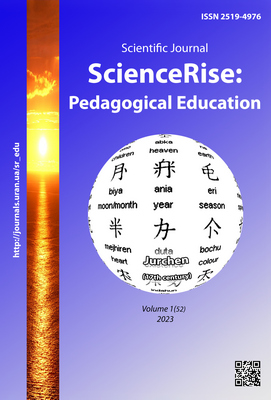Children’s play during wartime in Ukraine from the preschool teacher’s perspective
DOI:
https://doi.org/10.15587/2519-4984.2023.275023Keywords:
play, war, preschoolers, preschool teachers, facilitation, postgraduate pedagogical educationAbstract
The article analyzes the results of a study that reveals characteristics of preschool children play activities in the conditions of the war in Ukraine, which were collected in two regions of the country significantly different in the scope of military operations carried out, life activities of the population (in the temporarily occupied territory of Ukraine and territories under Ukrainian control), as well as peculiarities of preschool education itself. The objectives of the research were: to find and highlight changes in the content, types and organizational forms of play activities of preschool children in the conditions of war based on the results of observations by preschool teachers; to identify the level of awareness of preschool teachers regarding play resources as an effective tool for psychosocial support of children in war conditions; to determine the need for preschool teachers to develop their skills in facilitating children's play activities in war conditions for the introduction of appropriate measures in the system of postgraduate pedagogical education; to approve a set of diagnostic tools for further research. The results of the research proved that: 1) the war in Ukraine significantly changed a nature of play activities of preschool children compared to the pre-war period, which is reflected in: the dominance of various plots of military actions in the content of a play, while children play new roles (of a positive nature – military, rescuers, firefighters, volunteers, doctors, construction workers, etc.), conditioned by the new military reality; children's active use of toy weapons and toy substitutes for modern weapons; increased time, spent on computer games, including war-themed games; reduced time, spent on play in general and free play in particular; refusal of children from noisy, active games in favor of quiet, quiet play alone; growing need of children for greater attention of adults during the play; emotional excitement of children, dominance of negative emotions in the play; increased weight of creative activities in children's daily routine, including play. The specified changes are found both in play activities of boys and girls of preschool age; 2) preschool teachers are aware of the importance of play for supporting the child's well-being in wartime conditions. They consider the level of their own knowledge and skills to support play activities of preschoolers to be insufficient, and so understand the urgent need for their additional training In-service Teacher Training institutions in the area of play facilitation
References
- The right of the child to rest, leisure, play, recreational activities, cultural life and the arts (Article 31). Committee on the Rights of the Child (2013). General comment 17. Available at: http://ipaworld.org/childs-right-to-play/article-31/general-comment-17
- Feldman, D. (2019). Children’s Play in the Shadow of War. American Journal of Play, 11 (3), 288–307.
- Bankova, P. (2017). Children play war. The Belogradchik Journal for Local History, Cultural Heritage and Folk Studies, 8 (1), 113–132.
- Caillois, R. (2001). Man, Play, and Games. University of Illinois Press, 224 p.
- Hyder, T. (2005). War, conflict and play. Maidenhead, England: Open University Press, 113.
- Heikkilä, M. (2021). Boys, weapon toys, war play and meaning-making: prohibiting play in early childhood education settings? Early Child Development and Care, 192 (11), 1830–1841. doi: https://doi.org/10.1080/03004430.2021.1943377
- Levin, E. (2006). Diane, Nancy Carlsson-Paige. The War Play Dilemma: What Every Parent and Teacher Needs to Know. Teachers College Press, 124.
- Heizinha, Y. (1994). Homo Ludens. Kyiv: Osnovy, 250.
- Loboda, Yu. O. (2014). War and game in cultorologic conception of J. Huizinga. Hrani. Filosofiia, 10 (114), 23–24.
- Eisen, G. (1990). Children and Play in the Holocaust: Games among the Shadows. University of Massachusetts Press, 168.
Downloads
Published
How to Cite
Issue
Section
License
Copyright (c) 2023 Tetiana Gura, Oksana Roma

This work is licensed under a Creative Commons Attribution 4.0 International License.
Our journal abides by the Creative Commons CC BY copyright rights and permissions for open access journals.
Authors, who are published in this journal, agree to the following conditions:
1. The authors reserve the right to authorship of the work and pass the first publication right of this work to the journal under the terms of a Creative Commons CC BY, which allows others to freely distribute the published research with the obligatory reference to the authors of the original work and the first publication of the work in this journal.
2. The authors have the right to conclude separate supplement agreements that relate to non-exclusive work distribution in the form in which it has been published by the journal (for example, to upload the work to the online storage of the journal or publish it as part of a monograph), provided that the reference to the first publication of the work in this journal is included.








